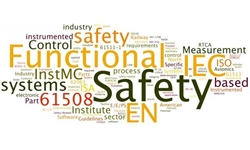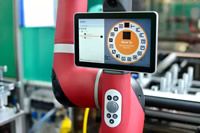Wind River Brings Safety-Critical Expertise to Functional Safety for Industrial IoT
With the accelerating growth of the Internet of Things (IoT), it is increasingly important to identify and implement safety-related systems for smart grids, connected vehicles, robotics, industrial control systems, smart factories, and more.
Disruptive Changes from Robotics Driving the Industrial Internet of Things (IIoT)
Cobots and mobile robots are both new technologies that are still being developed and industry is just now learning how to implement them. Further, these examples represent new applications that use robotics in applications where they have never been used before.
Rethink Robotics Releases Intera 5: A New Approach to Automation
Rethink Robotics announced Intera® 5, a first-of-its-kind software platform that connects everything from a single robot controller, extending the smart, flexible power of Rethink Robotics' Sawyer™ to the entire work cell and simplifying automation with unparalleled ease of deployment.
Built on the backbone of the industry's best train-by-demonstration software that powers the world's fastest-to-deploy robots, Intera 5 is paving the way for connected manufacturing environments and helping companies build factories of the future. Intera 5 fundamentally changes the need for integration, making it substantially easier and more affordable, allowing manufacturers to deploy full work cell automation in a matter of hours, not weeks.
Intera 5 is much more than the latest version of Rethink Robotics' software; it's a new way to approach automation that allows manufacturers to control the robots, orchestrate the work cell and collect data. Full Press Release:
Do the benefits of robotics outweigh the heavy demands on infrastructure?
Ben Rossi for Information Age: Robotics has already been deployed in manufacturing to great effect for over a decade, performing delicate and precise tasks with greater accuracy than humans.
But now cutting-edge robots and other smart machines are set to join forces with the rapidly expanding Internet of Things, which Gartner estimates will total 25 billion devices by 2020.
In healthcare, robotic services are already operating pharmacy dispensers and robotic trolleys are now deployed in a growing number of hospitals. In hospitality, robots deliver services such as drinks dispensing and automated trolley deliveries.
Robots have even made their way into education, where they are being deployed successfully as a tutor, tool or peer in learning activities.
But what impact will this large-scale adoption of robotics have on existing networks as they encounter inevitable further strain? Cont'd...
Robotics, automation, and how a strong network is needed to connect it all up
Manish Sablokk for IoTTech: Cutting-edge robots and other advanced smart machines are set to be added into the rapidly expanding Internet of Things, which is projected to reach 25 billion devices by 2020. Robotics has already been used in manufacturing to great effect for over a decade, performing delicate and precise tasks with a higher success rate than humans. With advancements such as 'deep learning' robots, delivery drones and ubiquitous knowledge-sharing between machines, widespread robotics adoption is becoming far more feasible.
In healthcare, there are already robotic services in operation with automated pharmacy dispensing and robotic trolleys - robots that can navigate between floors and even call the lift using a Wi-Fi sensor. The hospitality sector has also been a keen adopter of robotics to deliver services and in education, robots are being deployed successfully as a tutor, tool or peer in learning activities, providing language, science and technology education. Cont'd...
Records 16 to 20 of 20
Featured Product

NVIDIA RTX PRO BLACKWELL DESKTOP GPUs
NVIDIA RTX PRO - Built for Professionals - NVIDIA RTX PRO Blackwell Desktop GPUs feature the latest breakthroughs in AI, ray tracing, and neural rendering technology to power the most innovative workflows in design, engineering, and beyond.
Robotics and Automation - Featured Company

PI USA (Physik Instrumente)
PI is a privately held company that designs and manufactures world-class precision motion and automation systems including air bearings, hexapods and piezo drives at locations in North America, Europe, and Asia. The company was founded 5 decades ago and today employs more than 1700 people worldwide. PI's customers are leaders in high-tech industries and research institutes in fields such as photonics, life-sciences, semiconductors and aerospace.




